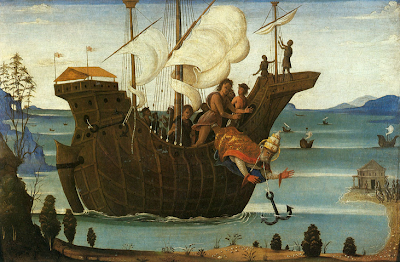Jesus knew that Andrew was walking behind him, and turning back, he asked, "What do you seek?" When Andrew answered that he would like to know where Jesus lived, Our Lord replied, "Come and see." Andrew had been only a little time with Jesus when he realized that this was truly the Messiah.
From then on, he chose to follow Jesus, and became the first disciple of Christ. Next, Andrew brought his brother Simon (St. Peter) to Jesus and Jesus received him, too, as His disciple. At first the two brothers continued to carry on their fishing trade and family affairs, but later, the Lord called them to stay with Him all the time. He promised to make them fishers of men, and this time, they left their nets for good.
From then on, he chose to follow Jesus, and became the first disciple of Christ. Next, Andrew brought his brother Simon (St. Peter) to Jesus and Jesus received him, too, as His disciple. At first the two brothers continued to carry on their fishing trade and family affairs, but later, the Lord called them to stay with Him all the time. He promised to make them fishers of men, and this time, they left their nets for good.
It is believed that after Our Lord ascended into Heaven, St. Andrew went to Greece to preach the gospel. He is said to have been put to death on an X-shaped cross, to which he was tied, not nailed. He lived two days, still preaching the Gospel to those who gathered around him in his last hours.
Almighty God, who didst give such grace unto thy holy Apostle Saint Andrew, that he readily obeyed the calling of thy Son Jesus Christ, and followed him without delay: grant unto us all; that we, being called by thy holy Word, may forthwith give up ourselves obediently to fulfil thy holy commandments; through the same Jesus Christ thy Son our Lord, who liveth and reigneth with thee, in the unity of the Holy Spirit, ever one God, world without end. Amen.
_____________________________________
Painting: "The Crucifixion of St. Andrew"
by Mattia Preti (1613-1699)


_-_James_Tissot.jpg)
.jpg)














